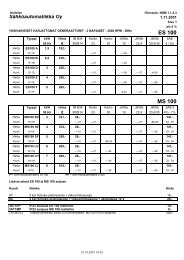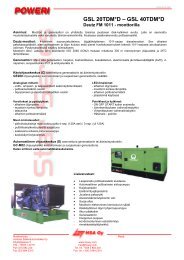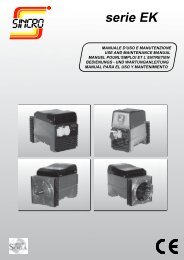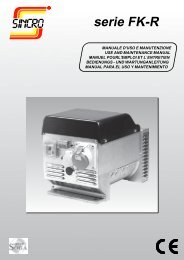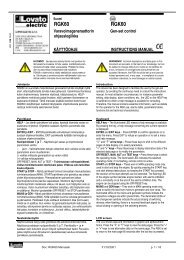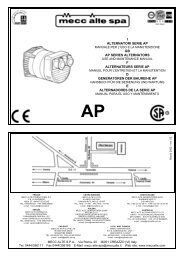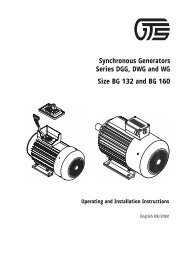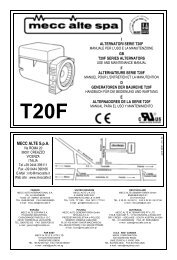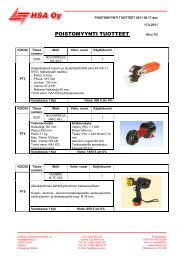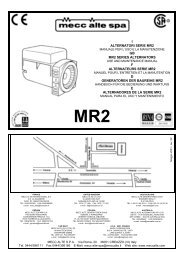You also want an ePaper? Increase the reach of your titles
YUMPU automatically turns print PDFs into web optimized ePapers that Google loves.
ACCOPPIAMENTO<br />
ELETTRICO<br />
PERICOLO<br />
DANGER<br />
L’accoppiamento elettrico e’ a cura dell’utilizzatore<br />
finale ed e’ eseguito secondo la sua<br />
sola discrezione.<br />
Per l’ingresso nella scatola morsetti si raccomanda<br />
di utilizzare passacavi e serracavi in<br />
accordo con le specifiche del paese di esportazione.<br />
COLLEGAMENTO AVVOLGIMENTI<br />
Sono previsti entrambi i collegamenti, stella<br />
con neutro (Y) e triangolo (∆) in tutti gli alternatori<br />
(tav. 2 pag. 58).<br />
Per passare da un collegamento Y a ∆ (es. da<br />
400V a 230V) e’ sufficiente spostare i ponti<br />
sulla morsettiera principale (vedere schema<br />
tav. 2 pag. 58).<br />
Nessun intervento e’ richiesto sul regolatore di<br />
tensione.<br />
I generatori sono costruiti di serie con 12 cavi<br />
di uscita per consentire di ottenere tensioni<br />
diverse (es.230 / 400 / 460 / 800V).<br />
I generatori, vanno sempre collegati a terra<br />
con un conduttore di adeguata sezione utilizzando<br />
uno dei due (interno/esterno) appositi<br />
morsetti.<br />
Dopo aver eseguito il collegamento (per le<br />
coppie di serraggio vedere tabella 20 pag.68)<br />
rimontare il coperchio scatola morsetti.<br />
IMPORTANTE: variazioni di frequenza.<br />
La macchina fornita per funzionare a 50Hz<br />
puo’ funzionare anche a 60Hz (o viceversa);<br />
e’ sufficiente tarare il potenziometro al nuovo<br />
valore nominale di tensione.<br />
Passando da 50Hz a 60Hz, la potenza puo’<br />
aumentare del 20% (corrente invariata), se la<br />
tensione aumenta del 20%; se la tensione<br />
rimane invariata la potenza, puo’ aumentare<br />
del 5% per effetto della migliore ventilazione.<br />
Per generatori costruiti appositamente per<br />
una frequenza di 60Hz nel passaggio a 50Hz,<br />
la tensione e la potenza devono necessariamente<br />
diminuire del 20% rispetto a quella<br />
riferita a 60Hz.<br />
REGOLATORI (tav. 3 pag 58)<br />
I regolatori tipo U.V.R.6/1-F e S.R.7/2-G possono<br />
essere indifferentemente usati nella serie<br />
<strong>ECO</strong>-<strong>ECP</strong> senza modificare le prestazioni.<br />
L’U.V.R.6/1-F e’ montato di serie nelle tipologie<br />
38 - 40 - 43 - 46, mentre l’S.R.7/2-G nelle<br />
serie 28-31-32-34.<br />
I due regolatori sono perfettamente uguali<br />
nelle prestazioni, ma si differenziano nelle segnalazioni<br />
e nel riferimento.<br />
22<br />
ELECTRICAL<br />
CONNECTIONS<br />
GEFAHR<br />
PELIGRO<br />
All electrical output connections are the responsibility<br />
of, and are at the discretion of, the<br />
end user.<br />
When making terminal box connections, all<br />
cable and terminal lugs should meet the relevant<br />
standards of the country of final destination.<br />
WINDINGS CONNECTION<br />
All alternators feature both star with neutral (Y)<br />
and delta (∆) connections (table. 2 pag.58) .<br />
To reconnect from a star to delta connection<br />
(for ex. from 400V to 230V), modify the linking<br />
arrangements on the output terminal board<br />
(see diagram on table 2 page 58).<br />
It is not necessary to adjust the voltage regulator.<br />
Standard alternators are equipped with 12 cables<br />
to offer different voltages (ex.230 / 400 /<br />
460 / 800V).<br />
The alternator must always be earthed by sufficiently<br />
rated cable, using one of the inside or<br />
outside terminals.<br />
After completing output connections (for tightening<br />
torque see tab. 20 pag. 68), ensure<br />
that the terminal box cover is securely in place.<br />
IMPORTANT: frequency variations.<br />
A standard production machine wound for 50<br />
Hz can also function at 60 Hz (and vice versa)<br />
by resetting the A.V.R. voltage potentiometer<br />
to the new nominal voltage value. When changing<br />
from 50 to 60 Hz the alternator power,<br />
and nominal voltage will increase by 20%, but<br />
the current does not change from 50 Hz value.<br />
Should voltage stay at 50 Hz nominal value,<br />
then the output power may be increased by<br />
5% due to improved ventilation.<br />
For machines wound for 60 Hz, changing to<br />
50 Hz, the voltage and power values have to<br />
decrease by 20% of 60 Hz value.<br />
REGULATORS (table. 3 pag 58)<br />
Either U.V.R.6/1-F and S.R.7/2-G regulators<br />
can be used on the <strong>ECO</strong>-<strong>ECP</strong> series without<br />
affecting performances.<br />
The U.V.R.6/1-F is a standard feature on the<br />
38-40-43-46 models whereas the S.R.7/2-G<br />
is standard on the 28-31-32-34 series.<br />
The two regulators ensure the same level of<br />
performance but have different signal systems<br />
and references.<br />
<strong>ECO</strong>-<strong>ECP</strong> MANUAL SEPT. 2005 REVISION 16



